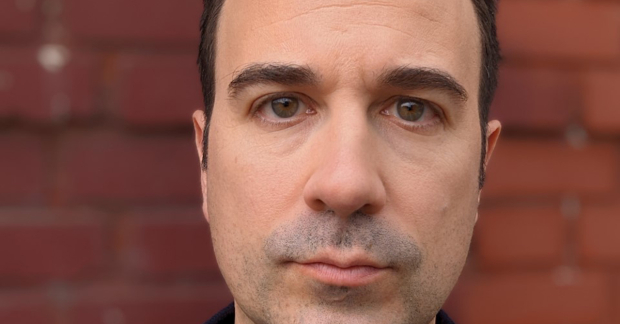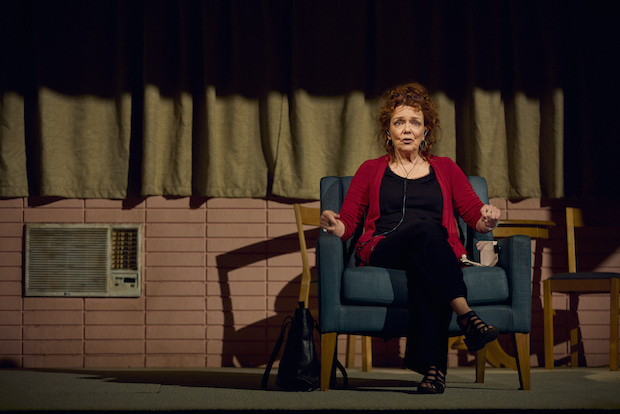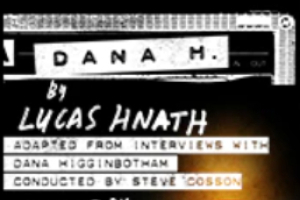Interview: Steve Cuiffo on Creating the Lip-Synch Magic of Dana H.
Cuiffo helped train leading lady Deirdre O’Connell for the task in Lucas Hnath’s acclaimed drama.
Lip-synched performances and Broadway rarely mix.
Theater typically prides itself on being live. Aside from a few prerecorded moments in mega-musicals such as The Phantom of the Opera, every word that comes out of a performer's mouth is unique to that moment. The industry-wide pride in temporality has even been name-checked in Tony Award telecasts. Enter the boundary dissolving Dana H., at the Lyceum Theatre through Thanksgiving weekend.
Dana H. is an entirely lip-synched play, crafted from interviews with playwright Lucas Hnath's mother. Deirdre O'Connell plays Dana without ever uttering a word, instead delivering a remarkably layered lip-synch performance as Dana shares her story in her own words.
Steve Cuiffo, an artist who combines magic, illusion, lip-synch techniques, and theater, served as the illusion and lip-synch consultant for Lucas Hnath's production. Here's how he helped pull off the feat of theater you see onstage.

(© Theo Mauritius)
This conversation has been condensed and edited for clarity.
How did you get your start in this line of work?
I started with magic as a kid. I went to NYU for acting training, and while I was there, I saw the Wooster Group for the first time. I went to the Performing Garage and saw The Emperor Jones with Kate Valk, and it was a revelation to me. A couple months before my graduation, Liz LeCompte asked me if I would be in the next piece. We were re-creating a show that they had [previously] made, and the first rehearsal was watching the old video and trying to imitate it. All 10 of us onstage trying to copy it — very outside-in, technical work.
My work with Lucas Hnath evolved over a long period of time. He went to NYU around the same time I was there and was always writing, trying very experimental ideas. One of the first workshops he and I did together, he had written a piece to be lip-synched, and all the actors wore tape recorders tied around their necks. I've worked on a handful of his plays now, including Dana H., that use some sort of illusory aspect to it.
In terms of lip-synching, in 2005 I met John Epperson, who's Lypsinka. John was working on a new piece, The Passion of the Crawford, which was a re-creation of an interview between Joan Crawford and John Springer. He was the big PR guy for Joan Crawford and Bette Davis back in the day. The show is the interview. John asked me to play the interviewer. (Read more about Lypsinka here.)
I went full force into learning how to lip-synch, and I got the ultimate lesson from the greatest master. What was unique about The Passion of the Crawford, which I think really relates to Dana H., is that it was an extended conversation, a dialogue, which has its own unique problems. When you're lip-synching a song there's the rhythm that helps you keep things together. With dialogue, you have to internalize the rhythm of a conversation.
I've always commented that what I always found amazing of those many, many performances I did with Lypsinka in The Passion of the Crawford, is that every night we would do it, it felt like a different show. It's still a live performance.
I'm sure there are traditionalists who would think, "Oh, giving the same line reading every night would feel like the same show every night," but that's not necessarily the case.
No, not at all. The final piece of the lip-synch puzzle was another solo project I did, an extended, many-year development of performing the material of Lenny Bruce, verbatim. It was me speaking, you would hear my voice, but the way I worked on that material was very similar to how I worked with Lypsinka. The personal task that I set myself was to be able to speak it in the same rhythm, timing, intonation as close as possible to what Lenny was doing. My concept for the piece was that you can't separate the meaning of what he's saying from how he's saying it.
It culminated in a re-creation on the 50th anniversary of his famous Carnegie Hall concert from 1961. I did it in 2011, two nights at St. Ann's Warehouse. It was a two-hour-and-45-minute verbatim re-creation.

(© Chad Batka)
How do you define "illusion," and what particular illusion work did you do on Dana H.? Was it different at all from the lip-synch work, or were they sort of one and the same in terms of title?
In the simplest form, illusion is when you see something that contradicts what you know to be true. Illusion is the methodology of creating something that is seemingly impossible using natural means.
Without saying too much, this was actually the experiment with Lucas when he was talking to me about what this piece was. He had this notion about using illusion almost in an invisible way. There's one moment…There's a blackout towards the end, and the lights come up and the room has totally transformed itself. Didi O'Connell is gone, the chair is gone, the bed is messed up, a lamp is knocked over, and the task was "is there a way to do this blackout very quickly?" We used some magic and illusion techniques that you would use to make someone disappear if you were watching a magic show, but also various set transformations. It's a very subtle use of illusion.
What would you say was the biggest difficulty for Dana H. for you?
When Lucas first told me what he wanted to do, I was nervous. Before Didi was a part of the project, I didn't know if I would be able to work with whoever it was to get to the level that Lucas was after. Working with Didi exceeded any of that in a great way. She took it to another level.
What do you hope an audience member remembers about Dana H.?
You can't leave that show and not feel the virtuosity of Didi's performance, which I love. I think the most unique thing about this piece is this very personal, intense, real story executed in a very theatrical way. That clash is so fascinating. Obviously there's so many great actors, but I imagine that if an actor was given a script of this story, it could smell a little phony. Lip-synching gives it a truth because you're hearing the actual person telling it, and the way that Dana is telling the story of something that really happened to her isn't the first way you would imagine somebody describing those types of events. What the audience takes away, that's up to them. But I think that they've never seen anything like it, and they definitely take something away that they've never felt before.









